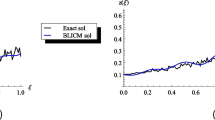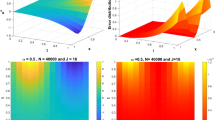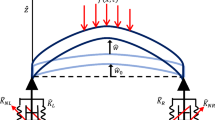Abstract
This paper considers the development of transient solution algorithms for finite element simulations of viscoelastic problems involving fractional integrodifferential operators. Specifically, numerical approximations are developed for the Grunwald-Liouville-Riemann formalism. This includes establishing formal error estimations. Based on the numerical representations of the fractional operators, implicit, explicit and predictor corrector type transient algorithms are derived for viscoelastic finite element simulations. To illustrate their computational properties, the results of several numerical benchmark experiments are presented. These emphasize the efficiency and stability of the various algorithms developed.
Similar content being viewed by others
References
Artin, E. (1964): The gamma function. New York: Holt Rinehart and Winston
Bagley, R. L.; Torvik, P.J. (1983): A theoretical basis for the application of fractional calculus to viscoelasticity. J. Rheology 27, 201–210
Bagley, R.L.; Torvik, P.J. (1983): Fractional calculus — a different approach to the analysis of viscoelasticity damped structures. AIAA J. 21, 741–748
Bagley, R.L.; Torvik, P.J. (1985): Fractional calculus in the transient analysis of viscoelastically damped structures. AIAA J. 23, 918–925
Bathe, K.J. (1984): Finite element procedures in engineering analysis. New Jersey: Prentice Hall
Caputo, M. (1976): Vibrations of an infinite plate with a frequency independent Q. J. Accoustical Soc. of America 60, 634
Courant, R.; Hilbert, D. (1962): Methods of mathematical physics. New York: Interscience
Duff, G.F.D. (1956): Partial differential equations. Toronto: University of Toronto Press
Guyan, R.J. (1965): Reduction of stiffness and mass matrices. AIAA J. 3, 380
Grunwald, A.K. (1867): Über begrenzte Deviationen und deren Anwendung. Z. Angew, Math Phys. 12, 441
Hildebrand, F.B. (1968): Finite difference equations and simulations. New Jersey: Prentice Hall
Knopp, K. (1945): Theory of functions. New York: Dover
Malvern, L.E. (1981): Introduction to the mechanics of a continuous medium. New Jersey: Prentice Hall
Padovan, J. (1976): On solutions to multiply connected nonself-adjoint systems subject to deterministic and nondeterministic excitations. Intern. J: Eng. Sci. 14, 819
Padovan, J. (1978): On gyroscopic problems in elasticity. Intern. J. Eng. Sci. 16, 1061
Ross, B. (1975): Lecture notes in mathematics. Berlin, Heidelberg, New York: Springer 457, 1–36
Riesz, M. (1949): L'integral de Riemann-Liouville et le probleme de Cauchy. Acta. Math. 81, 1
Sneddon, I.N. (1972): The use of integral transforms. New York: McGraw Hill
Zienkiewicz, B.C. (1984): The finite element method. New York: McGraw Hill
Author information
Authors and Affiliations
Additional information
Communicated by S.N. Atluri, August 19, 1986
Work partially supported by NASA Langley through Grant NAG-1-444
Rights and permissions
About this article
Cite this article
Padovan, J. Computational algorithms for FE formulations involving fractional operators. Computational Mechanics 2, 271–287 (1987). https://doi.org/10.1007/BF00296422
Issue Date:
DOI: https://doi.org/10.1007/BF00296422




